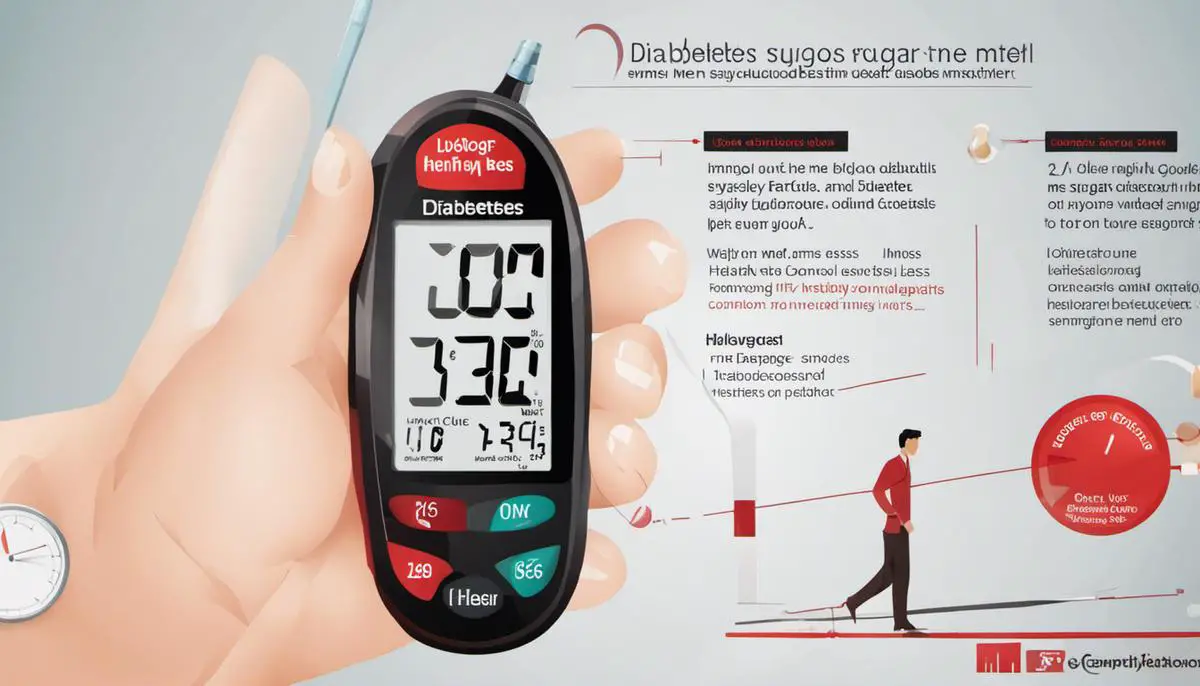Diabetes, a medical condition characterized by elevated blood glucose levels due to the body’s inability to produce or properly utilize insulin, is a pervasive health concern across the globe. In particular, men are increasingly susceptible to this disease, and its early detection can significantly impact the disease management and prognosis. Although the symptoms often vary, identifying the common and less obvious manifestations can lead to timely diagnosis and proper treatment. The understanding and awareness of diabetes, its causes, types, and specific effects in men serves as a crucial gateway to early interventions and potential lifestyle changes. Furthermore, acknowledging the significance of various risk factors and understanding their mitigation can play a significant role in the prevention of diabetes.
Understanding Diabetes
Understanding Diabetes: Glucose Processing and Insulin’s Role
Diabetes is a chronic disease that affects how your body turns food into energy. When we eat, a significant portion of our food is converted into a sugar called glucose. This glucose then enters your bloodstream. At this point, your pancreas is supposed to produce insulin, a hormone that enables the body’s cells to absorb and use glucose for energy.
Connections Between Diabetes and Gender
Diabetes affects both genders, but certain unique factors make men more vulnerable than women to this condition. For instance, men usually carry excess weight around their waist (apple-shaped body); this weight distribution has a higher risk of developing type 2 diabetes compared to weight that settles around the hips and buttocks. Men also tend to develop diabetes at a lower weight than women.
Spotting the Warning Signs of Diabetes in Men
Recognizing early symptoms can prompt timely medical consultation, which can help in slowing down the progression of the disease. Here are some common early signs of diabetes in men:
- Hunger and Thirst Increases: The body’s inability to utilize blood sugar effectively can trigger dehydration and feelings of constant hunger.
- Frequent Urination: The body tries to dispose of the excess sugar in the bloodstream through urine, causing frequent urination.
- Constant Fatigue: When your cells lack sugar, it can result in fatigue or an overall sensation of tiredness.
- Blurry Vision: High levels of blood sugar can affect your eyes, resulting in blurred vision due to lens swelling.
- Sexual Dysfunction: Diabetes could impair nerves and blood vessels leading to challenges in achieving and maintaining an erection.
- Unexplained Weight Loss: If your body isn’t effectively deriving energy from food, it’ll resort to burning fat and muscle for energy, causing unexpected weight loss.
- Frequent Infections or Slow Healing Wounds: Elevated blood sugar levels can compromise the body’s healing capabilities and its ability to fend off infections.
Not all men experience these symptoms, and their intensity can also vary. But if you start noticing any of these signs, promptly consult a healthcare professional for an accurate diagnosis.

Common Early Signs of Diabetes in Men
Understanding Frequent Urination
One of the initial symptoms of diabetes in men is frequent urination, medically known as polyuria. This happens when the glucose level in the body spikes. The kidneys, in an attempt to eliminate this excess glucose, end up producing more urine than usual.
Increased Thirst
Alongside frequent urination, men with undiagnosed diabetes may experience increased thirst often termed as polydipsia. When frequent urination occurs, the body loses a significant amount of fluid, leading to dehydration. To counteract this, the body triggers the thirst mechanism resulting in a high intake of liquids.
Unexplained Fatigue
Persistent, unexplained fatigue can also be an early sign of diabetes in men. When the body’s cells don’t receive the glucose they need for energy (due to a lack of insulin or insulin resistance), it can result in a deep-seated and ongoing feeling of exhaustion. This fatigue can happen even after plenty of sleep and can have a significant impact on everyday activities.
Sudden Weight Loss
Despite normal or even increased eating habits, sudden or unexplained weight loss is another early sign of diabetes. In type 1 diabetes, the pancreas stops producing insulin, without which glucose in the blood can’t enter the cells. The body then has to burn fat and muscles for energy, leading to weight loss. In type 2 diabetes, weight loss occurs because the body isn’t properly able to convert food into energy it could use, thus the body begins to break down proteins from the muscles as an alternative energy source, leading to weight loss.
Blurry Vision
One more common early sign of diabetes is blurred vision. High levels of blood sugar can cause swelling in the eye lens, which leads to difficulty in focusing, hence, blurry vision. It’s important to note that the changes to the lens are not permanent and normal vision often returns after blood glucose levels are under control.
Skin Conditions
Men with early diabetes may experience several skin-related symptoms. These can include dry skin, skin color changes, or an increased presence of skin tags. Severe itching, especially in the lower extremities, and slow wound healing are also common signs of diabetes. The skin issues are generally due to the poor circulation and high blood sugar levels associated with diabetes.
Erectile Issues as a Potential Indication of Diabetes
It’s not uncommon for men in the preliminary stages of diabetes to encounter issues related to sexual health. The most prevalent among these is erectile dysfunction. The reason behind this is that elevated blood sugar levels, commonly associated with diabetes, can cause damage to the blood vessels and nerves responsible for achieving an erection.

Less Obvious Symptoms
Neuropathy: Another Early Warning Sign of Diabetes
Another symptom that often goes unnoticed in men who might have undiagnosed diabetes is a tingling or numb feeling in their hands, feet, or extremities. This sensation is characteristic of a condition known as neuropathy. Progressively high sugar levels in the bloodstream, due to the body’s impaired ability to produce or use insulin properly, can lead to nerve damage, particularly in the extremities. However, remember that this discomfort can also be associated with other factors such as poor circulation or certain neurological conditions, and not exclusively to diabetes.
Slow Healing of Cuts and Wounds: An Indicator of High Blood Sugar
Looking to another clue, the slow healing of cuts or wounds can also be an early red flag for diabetes. A body’s efficient healing process depends on normal blood flow that delivers essential nutrients to the wound site. However, elevated blood sugar levels associated with diabetes can affect circulation and the body’s ability to fight off infections, resulting in slower wound healing. Prolonged recovery times are often more pronounced in the lower legs and feet, where circulation is poorer.
Frequent Infections: Broken Down Immune System
Another subtle symptom, frequent infections, whether bacterial, fungal, or yeast-based, may be an indicator of diabetes in men. Consistently high blood sugar can cause damage to the immune system’s components over time, impeding its ability to efficiently combat infections and ultimately leading to their increased frequency. Notably, urinary tract infections (UTIs) and skin infections are commonly reported in individuals with diabetes.
Sexual Dysfunction: Diabetes and Men’s Health
Finally, sexual dysfunction, particularly erectile dysfunction (ED), could be a symptom of early diabetes. Persistent high blood sugar levels can damage the nerves and blood vessels that control sexual function. ED is often a distressing symptom for men and could be indicative of undiagnosed diabetes, especially when associated with other aforementioned symptoms. In fact, some studies suggest that men with ED have a higher risk of developing heart disease, which is also closely associated with diabetes.
It’s heavily emphasised that some symptoms can be shared by other health-related issues, thereby making self-diagnosis unreliable. Instead of assuming, it’s wise to consult a healthcare professional if any of these symptoms persist or become a cause for unease. Prognosis can be significantly improved, and the risk of further complications can be lowered substantially with early detection and proper management of diabetes.

Risk Factors and Mitigation
Factors Contributing to Diabetes in Men
Various factors can increase the likelihood of men developing diabetes, including obesity, family history, age, lifestyle, and dietary patterns.
Obesity plays a substantial role, with a BMI of 25 or higher doubling the likelihood of diabetes development according to the American Diabetes Association. The logic here is that the heavier an individual, the harder their body needs to work to process sugar and effectively utilise insulin.
One’s genetic background is an additional crucial factor. A family history of diabetes, particularly in immediate relatives such as siblings or parents, puts you at a greater risk of developing the disease.
Age is another risk factor to consider since the likelihood of diabetes tends to rise substantially after the age of 45. This risk might be associated with age-related physiological changes, such as alterations in muscle mass and overall body composition, which can affect sugar processing in the body.
A person’s lifestyle significantly impacts their chances of developing diabetes as well. Sedentary habits coupled with a lack of physical exercise can lead to weight gain and associated health hazards, therefore, increasing the risk of diabetes.
Furthermore, diet can also have a significant influence. Consuming meals high in trans and saturated fats, sugars, and low in fruits, vegetables, and whole grains can raise your likelihood of having diabetes.
Early Signs of Diabetes in Men
Often, early signs of diabetes can be subtle and can be easily overlooked. These signs may include frequent urination, excessive thirst, unexplained weight loss, constant hunger, blurry vision, fatigue, and other skin problems.
Frequent urination and excessive thirst are related symptoms. As sugar builds up in your bloodstream, your kidneys work overtime to filter and absorb the excess sugar. When they can’t keep up, the excess sugar is excreted into your urine, which can trigger frequent urination, leading to dehydration and thus, an increased thirst.
Unexplained weight loss can happen even when eating regular meals. This happens because without enough insulin to move sugar into your cells, your muscles and organs become depleted of energy. This triggers intense hunger that may not subside after eating.
Persistent fatigue can occur because the body’s cells are deprived of sugar. As a result, you might become tired and irritable.
Reducing Diabetes Risks
Upon hearing about the potential risk factors and symptoms of diabetes, you may feel a bit overwhelmed. But don’t worry—there are effective ways to manage these risks. A foundation of regular physical activity and a healthy weight is immensely beneficial. And this doesn’t necessarily mean gym memberships or rigid exercise schedules. Even modest, daily activities like walking, gardening, or household chores can offer significant health benefits.
In addition to being active, a balanced diet can further decrease your chances of developing diabetes. This means incorporating plenty of fruits, vegetables, lean proteins, and complex carbohydrates into your meals, while actively cutting back on saturated and trans fats, sugars, and sodium.
Be mindful that regular monitoring and screenings are essential in early detection. If you identify with any risk factors for diabetes, make sure to schedule regular check-ups to allow for early treatments if diabetes develops.
Understanding that immediate intervention is a crucial aspect of managing diabetes can prevent or drastically slow down the onset of complications. Therefore, adopting a self-awareness approach towards your health and making necessary lifestyle changes could be key in preventing and treating diabetes.

When to Consult a Healthcare Professional
When and Why Should You Visit a Doctor?
Early intervention is paramount when it comes to recognizing early signs of diabetes in men. It’s worth noting that men often experience different symptoms compared to women, which unfortunately leads to late diagnoses in several cases. Signs that may suggest the onset of diabetes typically include increased thirst and frequent urination, extreme hunger, unexplained weight loss, fatigue, irritability, blurred vision, and regular infections.
Should any combination of these symptoms persist, it is strongly advised to schedule an appointment with a healthcare professional without delay. Remember, these symptoms may be indicative of several health conditions, not just diabetes. Thus, seeking a proper diagnosis from a medical expert remains vitally important.
The Risks of Delayed Diagnosis
Delayed diagnosis can lead to severe complications. When high blood sugar levels are left untreated, they can damage various body parts, including the eyes, heart, kidneys, nerves, and blood vessels. Men with undiagnosed diabetes may face the risk of developing serious complications such as stroke, heart disease, kidney disease, vision impairment, and erectile dysfunction. The risk is even greater for men who are overweight, have high blood pressure, or lead a sedentary lifestyle.
Further, persistently high blood sugar levels may result in a dangerous, life-threatening condition called diabetic ketoacidosis (DKA). Symptoms of DKA include rapid breathing, fruity-smelling breath, dry skin and mouth, and stomach pain.
Importance of Regular Check-ups
Regular health check-ups can help identify early signs of Diabetes in men. It is advisable to get screened if you are over 45 years old, especially if you are overweight or obese. Men with a family history of diabetes or belonging to specific ethnicities (such as African, Hispanic, Native American, Asian, or Pacific Islander) should start getting tested earlier because they are at a higher risk of developing diabetes.
Other risk factors that may need early and regular checkups include having high blood pressure, low HDL cholesterol, high triglycerides, a history of cardiovascular disease, or showing signs of insulin resistance.
Patient awareness and self-monitoring are essential elements in timely diagnosis and treatment. Regular health checkups and maintaining a healthy lifestyle are crucial in managing, delay, or even preventing the onset of diabetes.
Regular check-ups focus on monitoring blood glucose levels, blood pressure, and cholesterol levels. They also inspect the state of your heart, kidney, eyes, and feet to detect early signs of complications. Regular screenings empower you with information on your health status, enabling you to make healthier lifestyle choices and take appropriate steps towards diabetes management if needed.

Every individual, especially those at an increased risk of developing diabetes, should monitor their health for the signs and symptoms discussed. If such signs are persistent, it is imperative to consult a healthcare professional without delay. The ramifications of undiagnosed or untreated diabetes can be serious and lead to severe complications. Regular health check-ups are essential as they not only aid in early diagnosis but also enable better management of the condition. By being aware of the risk factors, understanding why and how they impact us, we can to some extent, control their influence through lifestyle adjustments and early interventions. Thus, it is, without a doubt, that careful vigilance and proactive health management is the first defence line against diabetes.
